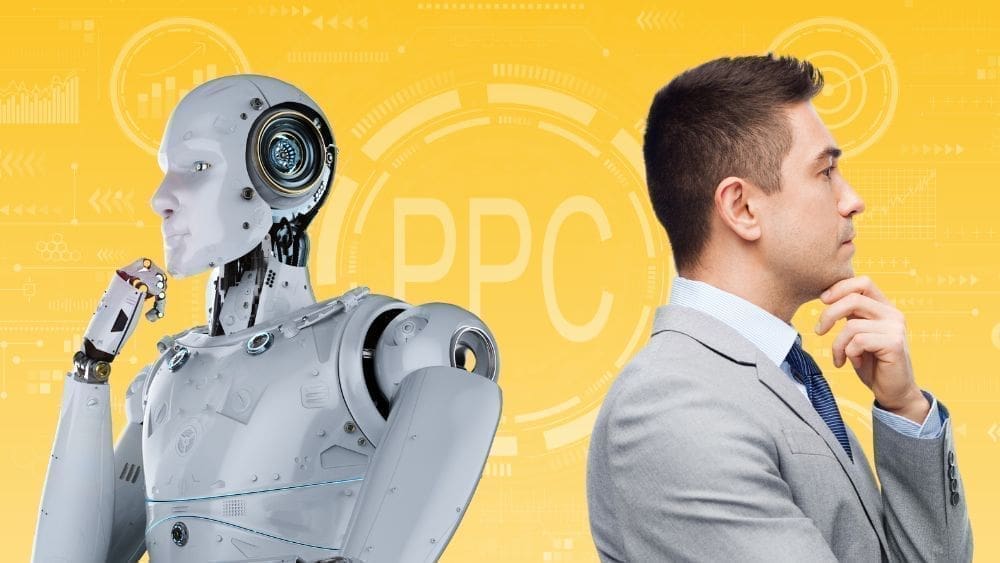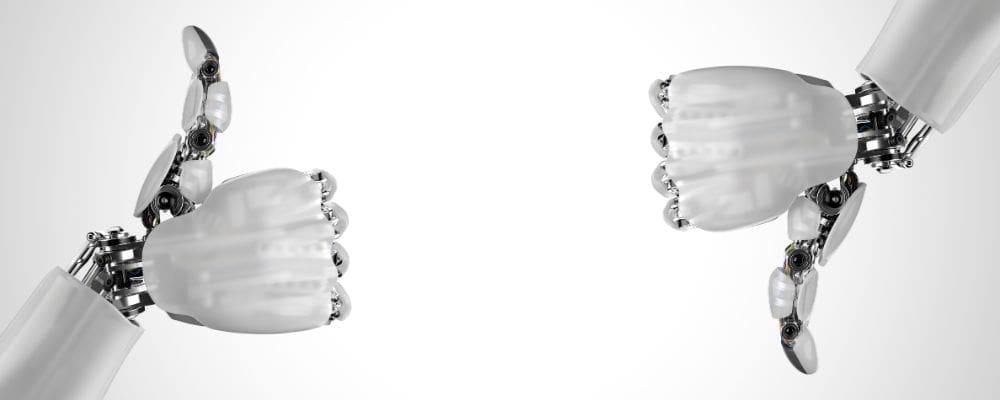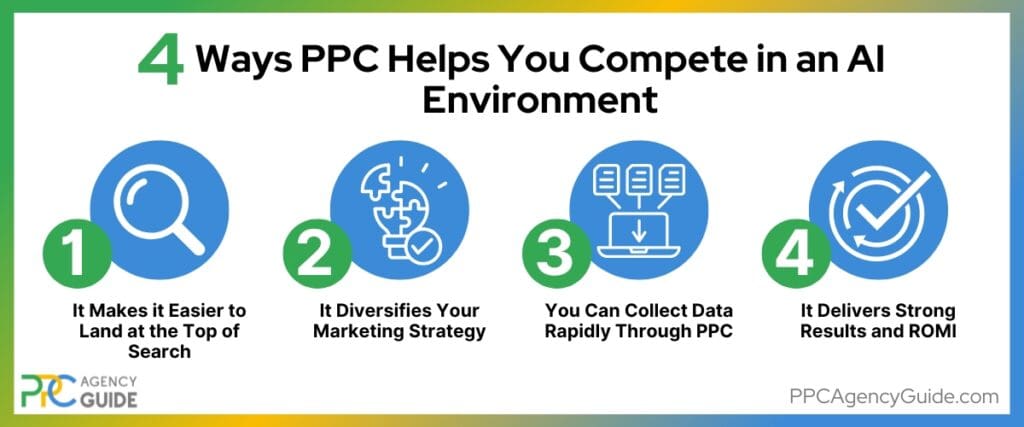
“Innovation is the ability to see change as an opportunity – not a threat,” Steve Jobs once said. As a tech pioneer and one of the greatest innovators of our time, he led Apple through developments such as the iPod, iPhone, iPad, and iTunes. Most of us would never have imagined how these things would shape our lives before they were released. It was a golden age of innovation.
Artificial intelligence (AI) is now experiencing a similar golden age. And while it’s undeniably impacting all areas of our lives and will continue to do so at breakneck speeds for the foreseeable future, one area of particular concern for businesses is marketing.
Whether you’re ready for it or not, AI already impacts all your digital marketing initiatives and their respective results. The question is whether you’ll innovate and seize the opportunities.
Countless digital marketing outlets have covered this development from the standpoint of leveraging the latest AI tech to improve content marketing and SEO. They’re not wrong. It’s incredibly powerful. However, between the influx of content and changes in how search engines like Google work, AI is increasingly creating new challenges in marketing.
Thankfully, pay-per-click (PPC) ads can help you gain and maintain a competitive edge despite all this. On this page, we’ll walk you through some of the ways AI is impacting your marketing results and how PPC will help you overcome the challenges.
Artificial Intelligence in Marketing Defined
“Artificial intelligence leverages computers and machines to mimic the problem-solving and decision-making capabilities of the human mind,” according to IBM’s definition.
When we look at this in the context of marketing, AI helps businesses identify who to target, which messages are most likely to convert them, when to reach them, and more.
Examples of AI in Digital Marketing
AI is infused in marketing so much that it’s often difficult to tell where it stops and starts. We’ll cover a few common examples of AI in digital marketing below.

AI in Targeting
If you’ve ever launched a Google Ads campaign from scratch or made a significant change to one, you’ve probably noticed that the platform displays a “Learning” notice in the bid status section for a period of time afterward. The platform is building a profile of the person most likely to take the action you’ve specified during this phase. When an ad will display for someone who fits within the profile later, the platform bids for ad placement on your behalf. Although Google keeps learning after this initial learning phase, the data it needs to start running optimized campaigns is primarily gathered early on.
AI-Generated Content
With ChatGPT growing in leaps and bounds, AI-generated content is one of the most talked about uses for AI in marketing. Brands are using it for everything, from topic generation to ad writing and the creation of full blogs.
Generative AI
Google has always been interested in providing users with the most helpful information and creating a seamless journey. We initially saw this with basic search listings. Then, the platform started using structured data to showcase information directly in search results. For instance, if you search for “weather,” Google automatically displays the latest weather conditions in your area and the forecast for the next week. Other examples of this include shopping results, snippets, and information panels. If you have a query that can be answered succinctly, Google usually provides that information in your results now rather than making you go to a webpage to find it. However, it still shows where the answer came from.
The next phase in the platform’s evolution is Generative AI Search. Now, the platform will answer your query on its own using the information it learned by crawling and indexing millions of websites. That means it’s no longer taking a single answer from a trusted website and linking to it. Instead, you’ll see Google’s answer that it developed by reading your content and content from other brands with a few options for continued reading on the side if the user wants to learn more.
Watch this video to learn how PPC can give your business a competitive edge in an AI-driven marketing environment
Benefits and Drawbacks of AI in Digital Marketing
Digital marketing has always been a rapidly evolving field, but AI is accelerating the speed of change. In some cases, it makes it easier for your brand to boost traffic and generate leads or sales. Other times, there are darker consequences.

Benefits of AI in Digital Marketing
AI has the potential to help brands work more efficiently, improve results, and boost return on marketing investment (ROMI) in lots of different ways.
Efficiency Improves
AI content generation tools make it easy to produce content quickly. Many marketing tools also use AI to automate processes, like scoring and nurturing leads.
Targeting is Easier
Through techniques like AI-enhanced targeting, it’s easier to zero in on your ideal audience. AI is also used to determine which type of content is most likely to resonate with a user and create personalized experiences. We often see this in shopping when a widget of other items you might like appears and in email marketing campaigns.
ROMI May Increase
When results are improved and produced with less effort, ROMI naturally improves. This gives brands more room in their budgets to expand their marketing efforts.
Drawbacks of AI in Digital Marketing
With all that said, the deluge of AI tools and techniques in digital marketing has some consequences. Brands must be aware of these in order to overcome them.
Massive Amounts of Data is Required
You need a minimum of 1,000 data samples per category for even the simplest machine learning algorithms to make decent predictions, according to nexocode research. So, let’s say you want to know if using an emoji in the subject line increases the likelihood of people opening your email campaign. You must send out a minimum of 1,000 emails before you might have an answer.
Now, let’s say you want to ensure you’re reaching the best possible audience. An AI algorithm might look at everyone who clicked your message and identify commonalities between them. You must have datasets for each trait, though you’ll probably need considerably more than 1,000 profiles to make an informed decision.
Let’s use golf as an example. We know that around eight percent of the population plays golf, according to Zippia research. In theory, eight percent of people who click your content will like golf, on average. But maybe you think golfers are statistically more likely to engage with your brand, and you’re considering using this to target customers. You must prove that more than eight percent of people who click on your content like golf.
Now, let’s say you’re running PPC ads, and your ad is displayed 1,000 times. Statistically, 80 people who see it will like golf. If you have a five percent clickthrough rate (CTR), four people who click will like golf. If five people who click the ad like golf, you have an uptick, but it’s not enough to bet on. This is why some algorithms require a minimum of 50,000 data samples before making any prediction.
This scenario plays itself out with countless variables. To use data for decision-making, you need lots of it. This is out of reach for many companies, especially small businesses, unless the data is gathered slowly.
It’s More Difficult to Rank Organically
As of February 2023, Google’s official stance on AI-generated content is that it’s acceptable. “Our focus on the quality of content, rather than how content is produced, is a useful guide that has helped us deliver reliable, high quality results to users for years,” the search engine reports.
This means two things. First, there is a deluge of content hitting websites now. Google’s standard process is to crawl and index it. Some sites, especially those with user-generated and news content, are crawled repeatedly throughout the day to ensure the latest information is accessible via search. If Google operates as intended, that means competition for rank is growing exponentially.
But we know that Google is not behaving like it usually would. Instead of remaining stable, rankings are sliding all over the place. “One page might be up 30 or 40 percent one day while another is down by a similar amount. This isn’t typical,” says one SEO pro via Search Engine Roundtable.
We also know that issues related to indexing have been acknowledged by Google. Just recently, the search engine stopped indexing news sites for several days. While it did not acknowledge what caused the problem, or even if it was related to an algorithm update, most SEO experts seem to agree that one of the platform’s latest changes to address spammy content had an unintended consequence.
Furthermore, there’s much discussion in the digital marketing community about new sites not getting indexed at all. Whereas the platform once almost instantly crawled and indexed new sites, even professionals who have been launching new sites for decades are reporting issues.
This brings us to our second point. It isn’t easy to get Google to acknowledge a brand’s existence these days. In other words, even if you can address this hurdle and your content is indexed, it may be buried in a sea of AI content.
AI is Dangerous as a Long-Term Strategy
“If you’re using machine learning tools to generate your content, it’s essentially the same as if you’re just shuffling words around, or looking up synonyms, or doing the translation tricks that people used to do,” Google Search Advocate John Mueller said mere months before it did an about-face and said AI-generated content is acceptable, as covered by Search Engine Journal. At the time, Mueller cautioned brands not to use AI-generated content and warned that Google would “see it as spam.”
“I think the biggest takeaway from this particular Q&A is that Google’s algorithms aren’t able to automatically detect content generated by language models such as GPT-3,” Search Engine Journal’s Miranda Miller said after the discussion. Since then, however, more sophisticated AI-detection tools have emerged, and they’re capable of detecting AI content nearly 90 percent of the time, as MarTech reports.
In other words, we know that Google flips its opinion, and we know that Google can theoretically tell if content is generated by AI. We could all wake up tomorrow and discover that Google has changed its stance again and is no longer ranking AI-generated content.
Yet, even if Google toes the line that it favors high-quality content regardless of its source, the quality of content generated by AI remains unpredictable. Those who bet on AI-generated content as a primary strategy today will likely be impacted as Google refines its algorithm in future updates.
AI Contributes to a Poor Customer Experience
Many brands are taking AI a step further and putting it on the frontlines to help address customer concerns. Unfortunately, this has led to disastrous outcomes. The chatbot managing the National Eating Disorder Association (NEDA) helpline is a prime example. Even though NEDA had trained its chatbot to answer questions accurately, it began recommending that users engage in the very behaviors that contribute to eating disorders, as CBS News reports. The organization subsequently shut its chatbot down and brought back human reps. While AI may someday be able to address these issues, it remains in its infancy. Entrusting it with sensitive issues without human oversight may have dangerous outcomes that extend far beyond marketing blunders.
AI Produces Inconsistent Results
We’ve already covered how trained chatbots can behave in unexpected ways, the unpredictable quality of content, and the volatility of search engine results, but it’s worth noting that AI will do whatever it chooses to do in the moment, and it’s impossible to gauge how it will respond in any given situation. The best description we’ve heard is that AI behaves like a student who hasn’t studied for a written exam. Some of what it generates is accurate, some is close to accurate, and the rest is purely made-up fluff to fill the empty space.
Perhaps what’s most alarming is that the quality of ChatGPT is getting worse, as Search Engine Journal reports. Whereas GPT-4 once had nearly 98 percent accuracy when asked math questions, just three months later, only two percent of questions were answered correctly.
While progress rarely occurs without some setbacks, it’s clear that it’s much too soon to put all your eggs in the AI basket.
How PPC Helps You Compete in an AI Environment
Now that we’ve explored how AI is impacting businesses let’s dig into how PPC can help your business compete amid these shifts.

PPC Makes it Easier to Land at the Top of Search
It takes considerable time and effort to rank well in Google under ordinary circumstances. With AI-generated content flooding search results and Google adapting its algorithm to provide better results, it’s even more challenging. PPC gets you to the top of search results instantly.
PPC Diversifies Your Marketing Strategy
We’ve already seen that SEO isn’t working as well as it once did or providing consistent results. Whether AI-generated content continues to be accepted by Google Search is anybody’s guess. Savvy brands are diversifying their digital marketing to ensure they have a steady stream of leads and sales regardless of what happens in these areas. These things don’t impact PPC, so it’s an easy way to diversify your marketing.
You Can Collect Data Rapidly Through PPC
You can learn a lot about your ideal customer quickly by running PPC ads, from what gets them to click to which offers they prefer and their interests. You can use the data to make more informed decisions across all areas of marketing.
PPC Delivers Strong Results and ROMI
PPC delivers $2 for every $1 spent on average per TechJury. It’s a solid marketing strategy in any environment. However, as we see returns diminish in other areas due to AI, keeping your ROMI high through techniques like PPC is much more critical.

Kick Off or Improve Your PPC Strategy
If you’re worried that the AI environment is impacting your marketing results or will in the future, diversify with a strong PPC strategy. To learn more or get started, request a complimentary consultation.


















